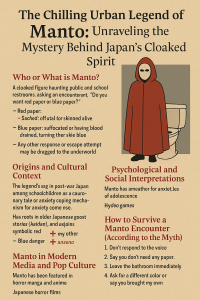Research Data
Post Type: Urban Legend
Type:
Location: Japan
Date of sighting:
Persons of interest: None
Results:
The Chilling Urban Legend of Manto: Unraveling the Mystery Behind Japan’s Cloaked Spirit
Summary
 Urban legends are a reflection of a culture’s fears and values, often passed down through generations with eerie consistency. In Japan, one of the most spine-chilling myths is that of Manto, a cloaked figure known for haunting school bathrooms and posing a question with deadly consequences. Similar in fame to Hanako-san, Manto has become a staple in Japanese horror folklore and continues to captivate and terrify to this day.
Urban legends are a reflection of a culture’s fears and values, often passed down through generations with eerie consistency. In Japan, one of the most spine-chilling myths is that of Manto, a cloaked figure known for haunting school bathrooms and posing a question with deadly consequences. Similar in fame to Hanako-san, Manto has become a staple in Japanese horror folklore and continues to captivate and terrify to this day.
Who or What is Manto?
Manto (sometimes referred to as “Red Cloak” or “Aka Manto” in Japanese) is a mysterious figure said to appear in public or school restrooms, most commonly in the last stall. According to the legend, Manto wears a red cloak or cape and a mask that conceals his or her face. The spirit is said to offer a chilling choice to those unlucky enough to encounter it: “Do you want red paper or blue paper?”
No matter how the question is answered, the result is usually fatal.
-
Red paper: The victim is either slashed until their clothes are soaked in blood or skinned alive.
-
Blue paper: The victim is suffocated or drained of blood, turning their skin blue.
-
Any other answer or attempt to escape often results in being dragged to the underworld.
Because of the unavoidable nature of the question, the only “safe” way to survive an encounter with Manto is to either ignore the voice completely or respond with something unexpected like “I don’t want any paper.”
Origins and Cultural Context
The origins of the Manto legend date back to the early 20th century, but it gained traction in post-war Japan, especially among schoolchildren. It’s believed to have originated as a cautionary tale or a coping mechanism for anxiety, particularly fears surrounding adolescence, isolation, or using public toilets.
The myth may also have roots in older Japanese ghost stories (kaidan), which frequently involve yūrei (restless spirits) returning to haunt the living due to unresolved trauma or unfulfilled revenge.
Symbolically, the colors red and blue are significant in Japanese culture:
-
Red often represents blood, violence, or danger.
-
Blue can denote death, the supernatural, or coldness.
By presenting these options, Manto confronts the victim with a no-win scenario, heightening the sense of horror and helplessness.
Manto in Modern Media and Pop Culture
Like many urban legends, Manto has transcended the oral tradition and found a place in various forms of media. The legend has been featured in:
-
Horror manga and anime
-
Japanese horror films
-
Video games, particularly in the survival horror genre
The story of Manto continues to evolve with each retelling. In some versions, Manto is a woman instead of a man; in others, the cloak is white or black rather than red. This flexibility has allowed the myth to persist and adapt over time.
Psychological and Social Interpretations
From a psychological perspective, the legend of Manto could be interpreted as a metaphor for the anxieties of growing up—particularly in a highly structured society like Japan. The setting of school bathrooms, typically private yet vulnerable spaces, adds another layer of discomfort.
Socially, urban myths like Manto serve as a form of communal storytelling, helping people bond through shared fear. They also reinforce behavior norms—like not talking to strangers or not staying out late alone.
How to Survive a Manto Encounter (According to the Myth)
While purely fictional, stories about surviving an encounter with Manto abound. Here are some common “tips”:
-
Don’t respond to the voice.
-
Say you don’t need any paper.
-
Leave the bathroom immediately.
-
Ask for a different color or say you brought your own.
Although humorous on the surface, these responses reflect the deeper need to exert control in a situation where one feels powerless.
Conclusion
The legend of Manto endures because it taps into some of our most primal fears—being trapped, making impossible choices, and facing the unknown. Whether you view it as a cultural curiosity, a cautionary tale, or pure horror, the story of Manto remains one of Japan’s most haunting urban myths.
So next time you find yourself alone in a quiet bathroom stall, and a voice asks if you want red or blue paper—think twice before answering.


